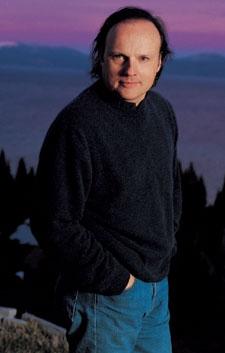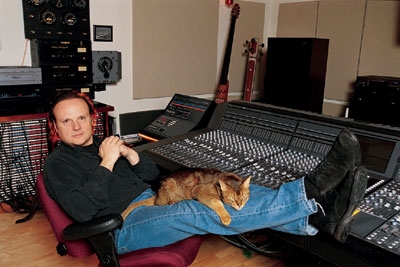Tales from the Dark Side

The scene: the London Planetarium. A fitting venue to visit The Dark Side of the Moon. But it's 1973, and this is the album's maiden voyage. And a quadraphonic mix, not approved by Pink Floyd, is being played on terrible, destined-to-be-forgotten speakers. The band members decline to attend and are represented by cardboard cutouts.
The scene: New York's Hayden Planetarium. Another fitting venue to go to the Moon. But now it's 2003, and this is the album's 30th-anniversary relaunch. And a six-channel mix for Super Audio CD, approved by the band, is being played on impressive ATC speakers. The band members still aren't here (their schedules won't allow it), but they're represented by their longtime engineer, James Guthrie, who mixed the album for surround sound. And while he certainly isn't made of cardboard, he admits he's a little stiff-and nervous.
That's because Guthrie's usual haunts aren't planetariums but, as he calls them, "dungeons," the small, dark studios where albums are recorded, mixed, and mastered-and where, occasionally, masterpieces like Dark Side are created. Guthrie wasn't at Abbey Road Studios for that album's creation, but he has been associated with Pink Floyd for nearly 25 years, since he co-produced and engineered the band's 1979 release, The Wall. So they chose him to remix Dark Side for Capitol's SACD. Which, at first, made him nervous.
After all, this wasn't just any old lunar expedition. The Dark Side of the Moon stayed on Billboard's Top Pop Albums chart for a record 741 weeks-more than 14 years. All told, in all formats, it has sold more than 30 million copies worldwide. And the album itself? It started off as just another LP for guitarist David Gilmour, bassist Roger Waters, keyboardist Richard (Rick) Wright, and drummer Nick Mason. But it ended up making history as both a record and a recording. With its kaleidoscopic music and laser-sharp lyrics, the album told a vivid tale of modern pressures and age-old insanity. And it was an amazing sonic adventure. As Wright has said, "It seemed like everyone was waiting for someone to make this album. It touched a nerve."
No wonder Guthrie was nervous. Yes, he had done surround mixes of Pink Floyd: The Wall for DVD-Video and Waters's In the Flesh for SACD. But this was different.
"There were certainly some sleepless nights before I started," Guthrie says. "I vacillated wildly between how conservative I should be and how far I should go. In the end, I thought to myself: 'This is silly. I'm just going to forget about all of that stuff and concentrate on the music.' Because there's only one important thing here: Is it emotionally satisfying?"  Guthrie and Louis stretch out in his studio, Das Boot.
Guthrie and Louis stretch out in his studio, Das Boot.
I'm talking with Guthrie in his home studio, Das Boot, named by a visiting band in recognition of Guthrie's "fixation" on submarines-specifically, American diesel boats of World War II. And indeed, his studio is adorned with gauges that summon up small, dark spaces of the past. Yet the London-born Guthrie has finally escaped the studio dungeons of his own past. His "Boot" is a spacious, comfortable room, with three long windows affording a spectacular view of the Sierra Nevada Mountains that surround his Northern California home.
This is where Guthrie and his assistant engineer, Joel Plante, started work on Dark Side last November-when the original 16-track master tapes arrived from Abbey Road Studios. "The tapes were in quite good condition," Guthrie says, "but they weren't well marked or logged. At first, we only had handwritten track sheets and a few scribbled notes. But then the terrific librarian at Abbey Road, Ian Pickavance, sent over copies of the daily job sheets. So we were able to do a great deal of sleuthing work.
"We were always trying to find little bits of music to make sure we had everything. As far as I was concerned, it was not acceptable to miss even one element. And I hope we haven't."
By the middle of January, Guthrie was ready to play his initial six-channel mix for each member of Pink Floyd. "I didn't know what to expect. They're a fairly low-key band-just in terms of their characters. They don't get excited easily. But they were very enthusiastic about this SACD. I haven't seen Rick and Nick like this for years. The band asked for some changes, but thankfully, none of them were major. And there was very little in terms of the placement of instruments. It's crucial for fans to understand that this mix has the band's input and endorsement."
He acknowledges that some fans are wondering why the album's original engineer, Alan Parsons, wasn't involved with the remix. It was Parsons who did the quad mix in 1973.
"The band listened to that quad mix and elected not to use it," Guthrie says. "I used the original stereo mix as my guide, because it captured the detail and emotion of the songs.
"The focal point of the six-channel mix is the listening position, not any of the speakers. What I have tried to do for many, many years is to make the speakers disappear-so that you're aware of sound being everywhere. You get immersed in the sound and can experience the music.
"When you first listen to the mix, it's very easy to think that everything is everywhere. But in fact, there are things moving around, there are elements in the back. But it's all for a reason, and it's relevant to the music. In the end,
I wanted to keep the album's homogeneous sound but also try to spread it out. It was a combination of keeping the heart and soul of the original but also making use of the larger soundstage."























































